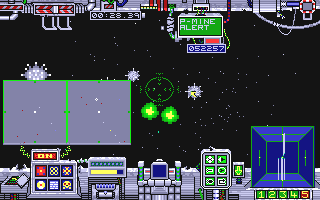Retro Replay Review
Gameplay
Deep Space delivers a focused, arcade-style action-simulation experience set in the vast reaches of alien territory. Players assume the role of an owl-headed freelance buccaneer, dispatched on a one-way raid to locate and destroy the enemy mothership. From the outset, the game emphasizes quick thinking and split-second decision-making: dogfighting hostiles, navigating minefields, and avoiding drifting asteroids all require precise control inputs and careful situational awareness.
(HEY YOU!! We hope you enjoy! We try not to run ads. So basically, this is a very expensive hobby running this site. Please consider joining us for updates, forums, and more. Network w/ us to make some cash or friends while retro gaming, and you can win some free retro games for posting. Okay, carry on 👍)
One of the most distinctive gameplay mechanics is the cargo scoop, which allows you to collect enemy pilots who have ejected from their vessels. Steering your long-range fighter beneath a helpless alien flyer and hauling them aboard offers a tense, almost puzzle-like challenge—especially when under fire. Successfully scooping up an alien not only ramps up the immersion but also rewards you with extra credits, which can be spent on vital resources like fuel drones or powerful quark bombs.
Deep Space foregoes a traditional campaign structure in favor of single-session sorties. Each session unfolds in one of five star systems, each with its own map layout and escalating difficulty curve. Whether you’re skimming fuel from a hulking gas giant to avoid mission-ending stranding or weaving through dense minefields, the game continually tests your resource management skills alongside aerial combat prowess. The result is an addictive, high-stakes loop that keeps you coming back for “just one more run.”
Progression in Deep Space is measured purely by credits earned through combat achievements: ship kills, observation post destructions, mine clearances, and alien captures all contribute to your final tally. This straightforward reward model eliminates complex upgrade trees but heightens the thrill of each encounter—every success immediately translates into tangible benefits, whether that’s a drone repair, a fuel top-up, or a devastating quark bomb to turn the tide of battle.
Graphics
Visually, Deep Space employs the signature Psygnosis art style of the mid-’90s, combining simple 3D wireframe models with richly detailed cockpit overlays. The external models of enemy ships and asteroids are rendered in basic polygons, giving them a cold, geometric feel that perfectly complements the game’s stark space environments. While these visuals may feel dated compared to modern standards, they retain a nostalgic charm and allow the game to run smoothly even on modest hardware.
The highlight of Deep Space’s presentation is undoubtedly its deluxe cockpit view. Every dial, gauge, and switch is meticulously illustrated, creating an immersive bridge from which you launch your raids. Mouse-driven interactions let you toggle shield generators, adjust power distribution, and deploy drones with satisfying precision. The depth of control this affords is rare in spaceflight games—and it’s a delight to explore each function as you hone your piloting skills.
Environmental hazards, such as minefields and asteroid belts, are portrayed through simple yet effective graphical cues: floating mine clusters pulse ominously, while dark, irregular masses drift silently past your viewport. These minimalist designs ensure that threats remain clear and readable, even amidst the chaos of a pitched space battle. Visually, the game strikes a fine balance between clarity and atmosphere.
Although Deep Space doesn’t push polygon counts or texture resolutions, its cohesive visual identity and functional cockpit interface more than make up for any technical limitations. For players who appreciate purposeful design over flashy effects, the game’s graphics remain engaging and wholly in service of the core action.
Story
Deep Space’s narrative is refreshingly concise: you are a lone mercenary owl-headed pilot on a deep penetration strike against an alien armada. There are no branching dialogues or cutscene epics—just you, your ship, and the cold void of space. This stripped-back approach places the emphasis squarely on gameplay, letting your actions tell the story of each harrowing sortie.
Despite its minimal exposition, the game manages to convey a sense of high-stakes drama. The very notion of a “freelance buccaneer” implies a savage frontier mentality, and your objectives—destroy alien outposts, capture enemy pilots, mine fuel from a gas giant—create a vivid tapestry of risk and reward. The lack of hand-holding further reinforces the impression that you’re operating far from any safe harbor, with only your wits and piloting prowess to rely upon.
Atmospheric touches, such as the muffled communications from your command center and the occasional urgent pings of distant sensor contacts, add flavor without bogging down the pace. There’s a raw, almost noir sensibility to the story beats—every mission briefing feels like a clandestine contract, every engagement a matter of life or death.
In the end, Deep Space’s narrative may feel skeletal compared to modern story-driven space sims, but it excels in delivering the essentials. You’re not on a sprawling interstellar odyssey; you’re a guns-for-hire with one job—and that singular focus suits the game’s intense, session-based structure perfectly.
Overall Experience
Deep Space stands out as an early example of action-oriented space simulation that remains engaging decades after its release. Its blend of arcade-style dogfighting, resource management, and cockpit simulation mechanics creates a unique hybrid that rewards both quick reflexes and strategic planning. Every mission feels consequential, thanks to the precarious fuel and repair systems that keep you on edge until the very end.
Newcomers may face a steep learning curve as they acclimate to the dense cockpit controls and the nuances of fuel skimming and cargo scooping. However, once the basics click, there’s an undeniable thrill in mastering each star system’s challenges—be they tightly clustered asteroid fields or sprawling mine networks. The single-session format also makes it easy to jump in for a short burst of adrenaline-fueled gameplay, without needing to commit to long campaign stretches.
While the graphics may not rival today’s polygon-heavy simulators, the game’s cohesive art direction and detailed instrument panels continue to impress. Coupled with the streamlined reward system—credits earned translate directly into drones or weapons—the experience never feels bloated or grindy. Instead, each run offers immediate feedback and a clear path to improvement.
For fans of retro space sims or anyone looking for a fast-paced, cockpit-centric shooter, Deep Space remains a worthy play. Its singular mission design, coupled with the quirky owl-headed protagonist and the satisfying mechanics of scooping and repairing, make it a memorable jaunt into the void—one that still delivers genuine excitement and challenge to this day.
 Retro Replay Retro Replay gaming reviews, news, emulation, geek stuff and more!
Retro Replay Retro Replay gaming reviews, news, emulation, geek stuff and more!









Reviews
There are no reviews yet.